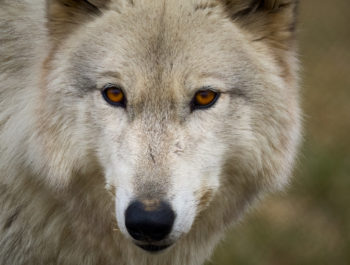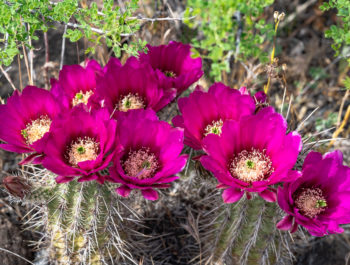Sony 14mm GM and Sony a1 Camera – Sony’s Gift to Landscape Photographers
Part V on Image Quality (IQ)
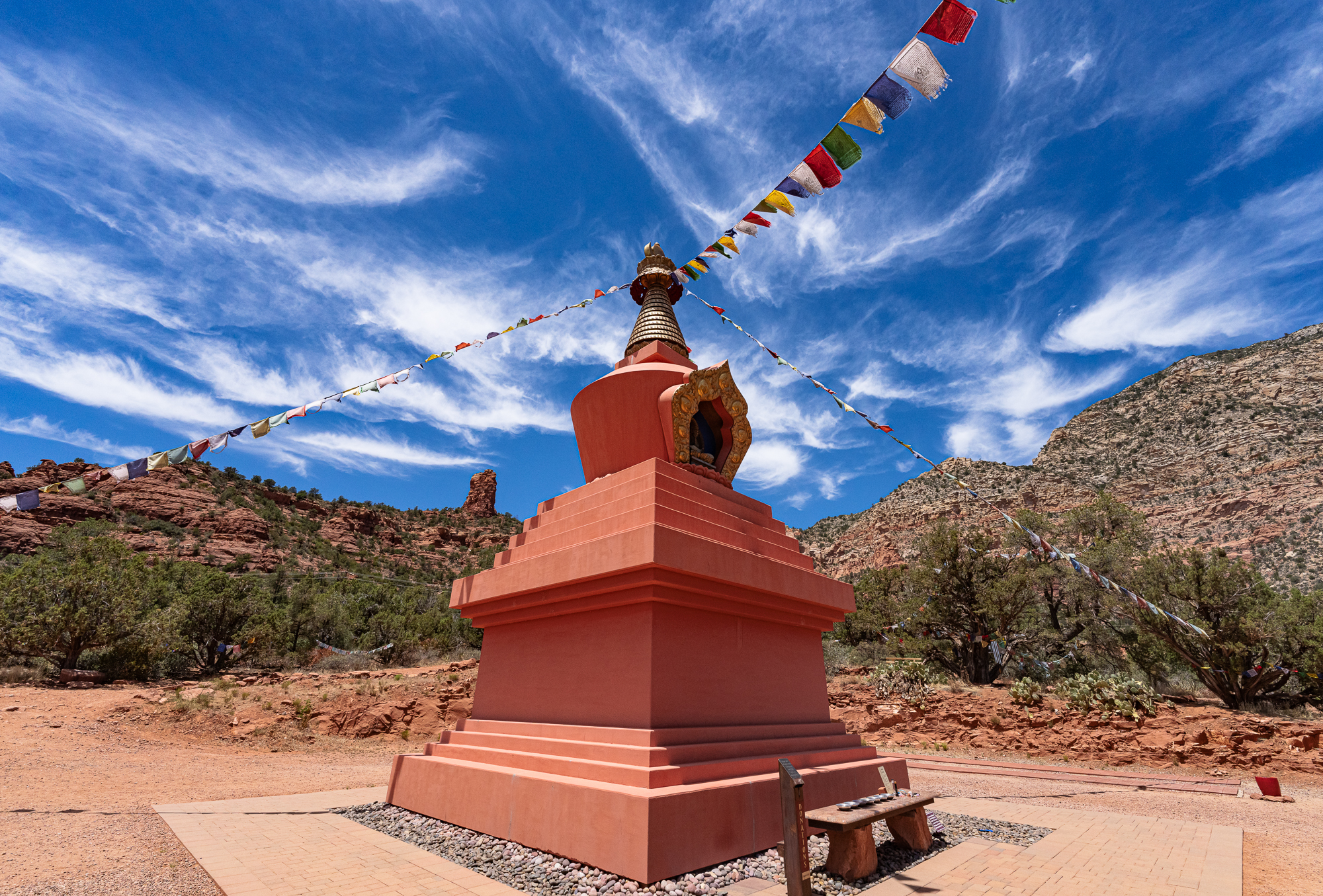
It takes two photographic elements to produce images with fine detail: the recording medium and the lens. It has always been that way no matter what light-capturing medium was used or which type of lens. Throughout the plate, film, and early digital media periods–1840 to 2010–lens designers had it relatively easy. Professional lenses easily out-resolved light recording media.
In large part, this was because the many professional cameras were medium and large format cameras that did not require high levels of enlargement in the final print. Once 35mm format became the choice of many professionals, high enlargement ratios became the norm requiring lenses capable of greater resolution and optical correction. From roughly 2010 on, camera manufacturers and lens designers were joined in a race to capture finer detail, greater color accuracy with minimal optical distortion. Until recently, high resolution requirements were satisfied by using specialized lenses like telephoto’s and macro lenses. Within recent years, demand for high resolution has extended to a broad array of optics.
As a landscape photographer, an abundance of fine detail has always been my priority, informing my choices of cameras and lenses. More recently, my desire for fine detail has become part of my standards for wildlife and travel photography as well.
Many of my articles have covered aspects of this trend. The most recent one, published May 28, 2021, mentioned my pairing the Sony Alpha 1 with manual focus Zeiss Loxia and Voigtlander APO prime lenses in the wide to short telephoto focal lengths, along with Sony’s longer GM lenses, to consistently achieve the highest possible image quality. My lens line-up covered 21mm to 600mm in focal lengths with no significant gaps, except in the ultrawide category.
What I wanted was a superb 14mm lens covering a 104 degree horizontal field. Almost all available 14’s were soft in the edges and corners with varying degrees of optical distortion. The Sigma 14mm f1.8 Art lens was closer to my performance criteria, but not good enough. Plus, it weighed 2.6 pounds, and cost $1,598. So, I waited for something better to come along. Thanks to Sony, the wait was “only” eleven years. (My Nikon 14-24 zoom was excellent for its time, but not up to today’s standards.) Sony’s latest coup far exceeds what I thought was possible.
I am not alone in this regard. All the regular Internet photo-gear bloggers were simultaneously surprised and amazed how Sony was able to create superb optical performance in a compact, light 14mm lens. The reviews all noted the crisp high resolution in the central portion of the lens at the maximum aperture of f1.8, with good edge resolution and acceptable corners, and pointed out that excellent corner to corner resolution was achieved by stopping down to f2.8 and smaller. Underlying this performance is a high degree of correction for chromatic and spherical distortion that helped achieve high sharpness and color accuracy. And, going in the other direction, because of the relatively large f1.8 opening, this lens can produce sharp close-ups separated from de-focused backgrounds with good Bokeh.
The reviewers also made the point that perspective distortion is intrinsic to wide-angle lens geometry, and therefore affects the Sony 14mm GM as well, but can be minimized by keeping the sensor plane as parallel to the viewing plane as possible. This was of little concern to me, as mild convergence and divergence of vertical lines are easily corrected in Lightroom. Many reviews praised the Sony 14mm GM’s almost perfect flare resistance, both remarkable and necessary in a lens that covers so much ground and sky. The current consensus is that the Sony 14mm GM is one of the three or four best GM lenses that Sony has yet produced.
From sample images and everything that I read, I felt this lens mounted on a Sony Alpha 1 would be an ideal marriage. I ordered it immediately, and have been enjoying the fresh and unique perspectives that this lens produces for the past month. It promotes a new way of viewing every scene and often tells a story of about each capture more effectively as I will expand on throughout this article.
Before each outing, I select the specific lenses geared to the images that I expect to capture, as I don’t like to tote around too much equipment. There are only two lenses that I always carry in my sling backpack because of their versatility and overall excellence. This 14mm lens is now one of three. It will produce a high percentage of winning images. It is able to integrate wide expanses of foreground and background to tell a clear, colorful story. At 3.3 inches in diameter and 3.9 inches long, it is compact and weighs 16 ounces. There is no valid reason to ever leave it at home.
So, what are the best uses for the Sony 14mm f1.8 GM? There are three obvious categories:
- Landscapes (both Grand Landscapes and Intimate Landscapes)
- Architecture & “City-scapes”.
- Night-skies
(And because of this lens’ unexpected versatility and creative inspiration, a fourth category might prove to be: “Everything Else”.)
LANDSCAPES
Landscape images that have both significant foregrounds and backgrounds can be placed in three categories.
Images with foregrounds and backgrounds of equal importance.
Sedona red rock formations are equally suitable as independent subjects or as backgrounds. The following four images illustrate my latest efforts to feature spectacular Agave Parryi flower stalks in relation to their surrounding environment. My first effort with this lens produced great detail, but was compositionally weak, as I stood where the Agave stalk hid a background utility pole rather than in a compositionally optimal spot. However, capturing the Hummingbird about to land on an Agave flower did add more interest to the composition.
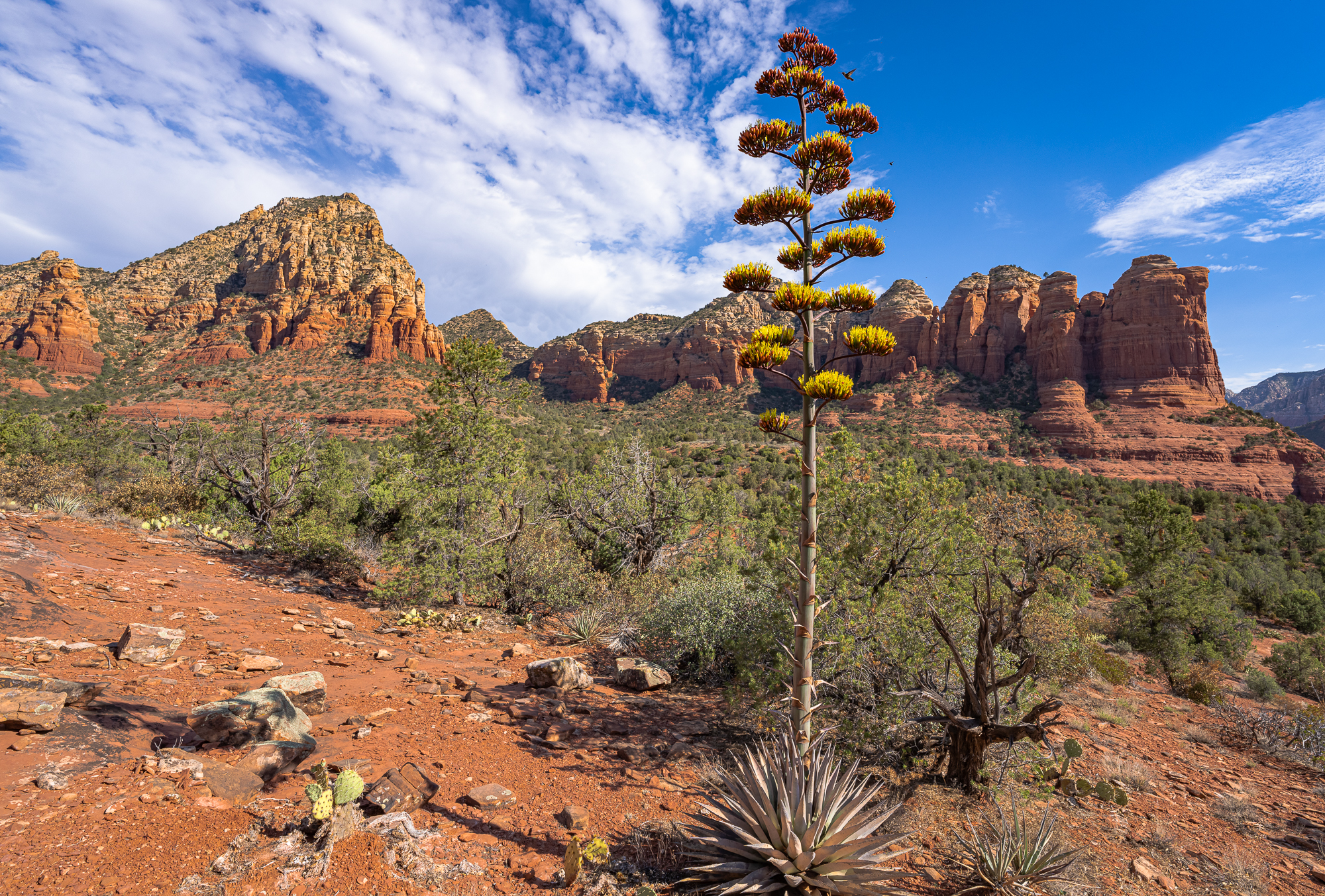
For my second attempt, I stood more to the right to place the Agave where I wanted it vis-a-vis the Coffeepot Rock Formation and later erased the utility pole from the image. I had to wait a while though to capture another bird about to land on top of the Agave stalk.
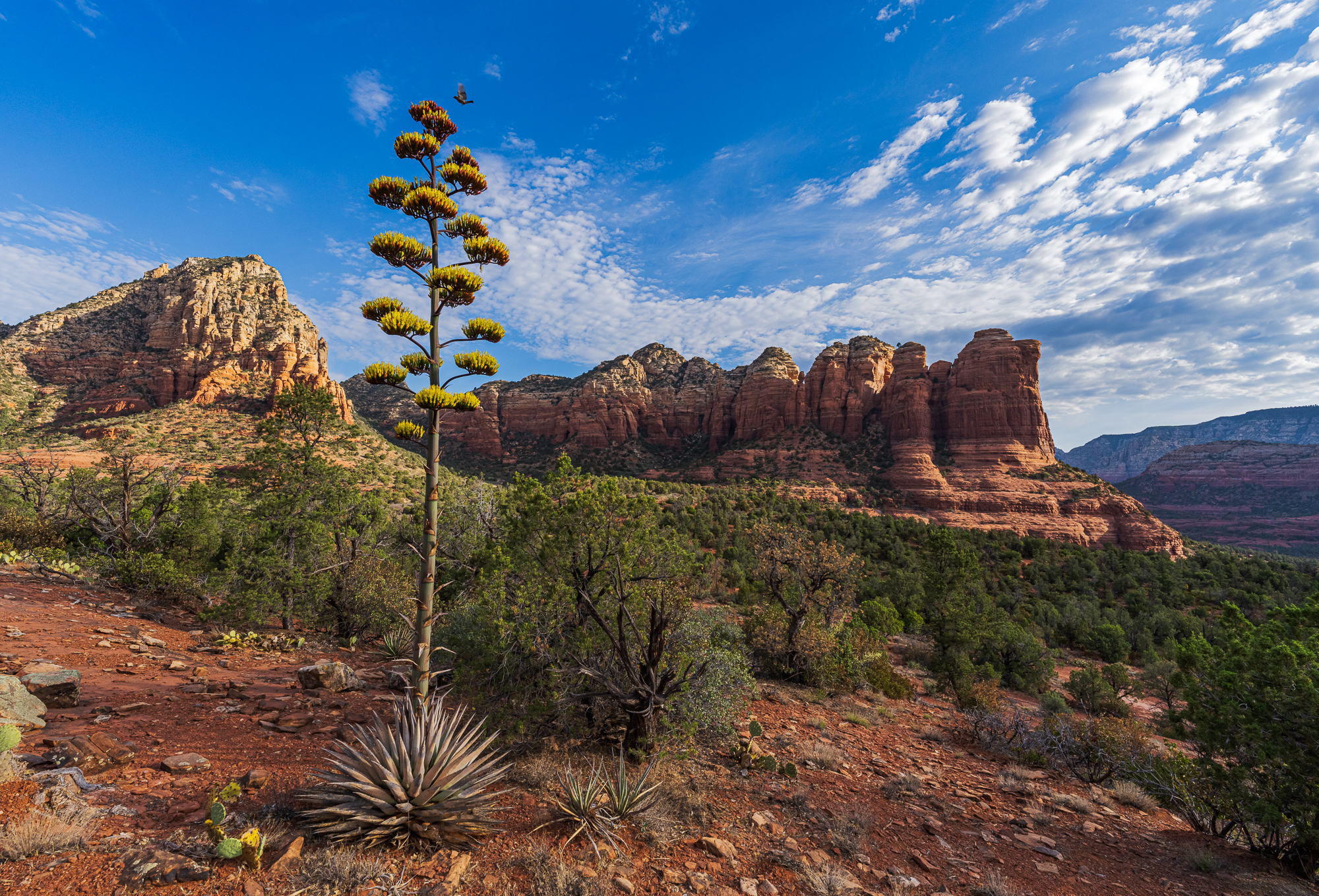
Later, I found another Agave in a different location and made a vertical exposure to place more emphasis on the Agave. This format is more suitable for magazine publishing, and also shows more foreground.

The above vertical composition also gave me the idea to improve the composition of the first exposure by cropping out the left part of the image to produce another vertical, as shown below. The 50 MP images produced by the Sony Alpha 1 allow for very usable final images even after substantial cropping. This also worked well, as cropping out almost half of the image caused both the Agave and Coffeepot Rock to be larger in the final image.
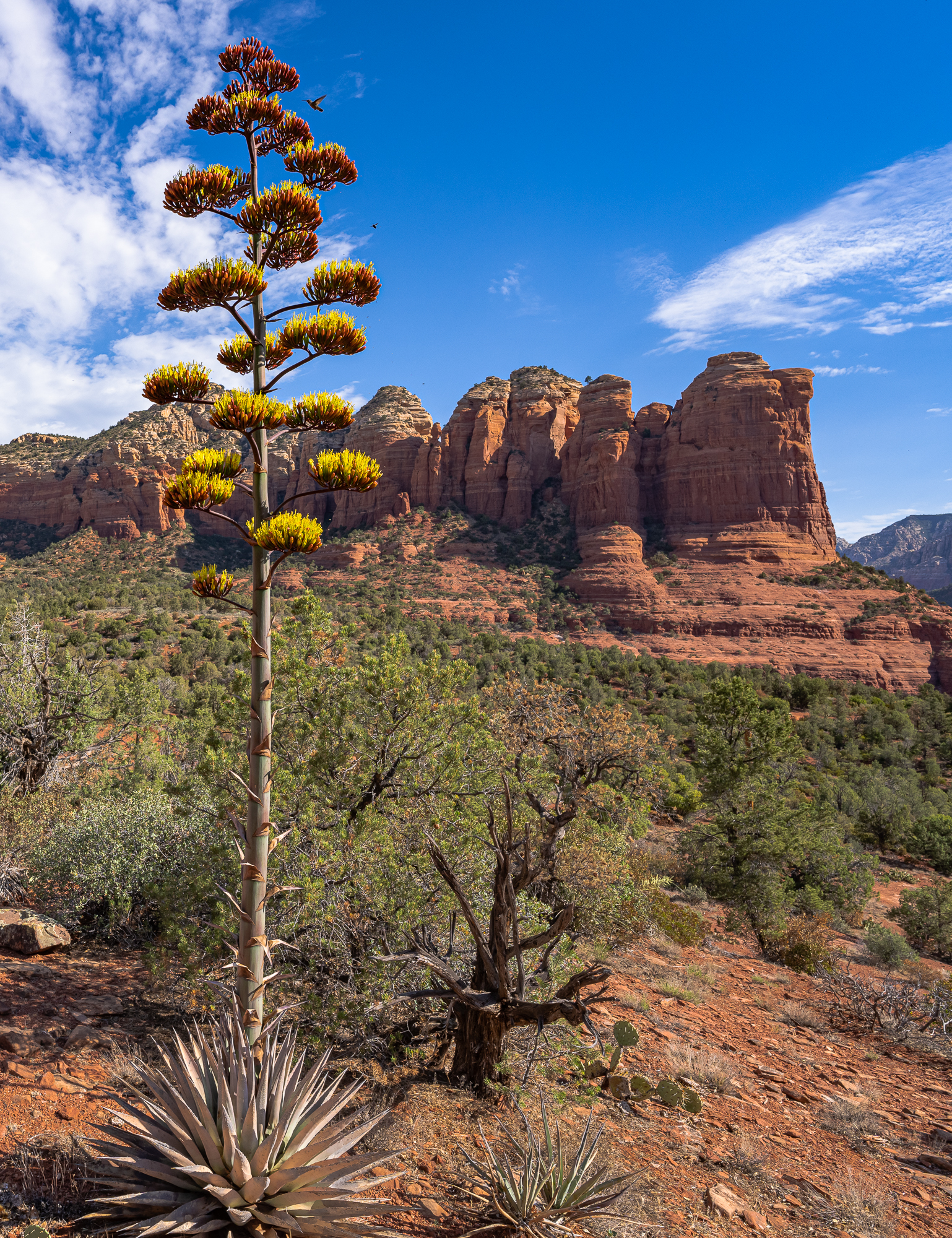
All four of the above images show great detail, color, and tonal rendition to be expected with an Alpha 1 utilizing a top-quality lens. Despite the extreme wide-angle perspective of the 14mm lens, there is no noticeable vignetting, distortion or falloff in resolution. This is a very different performance from those of older ultra-wides. Of course, some of this is automatically corrected in post-edit. The four images are also given weight to both the foreground and the background, which was my objective.
The next four landscape images shift to a mountain environment, but also fall into the category of giving equal weight to both foreground and background. However, here the foreground is seen as a natural extension of the background. The images show Bridal Veil Falls, the longest cascade in Colorado. The falls are in open shade, while the lower stream is sunlit. However, the difference in luminosity is not problematic due to the wide dynamic range of the Sony Alpha 1 camera and the outstanding flare resistance of the Sony 14mm f1.8 GM lens.
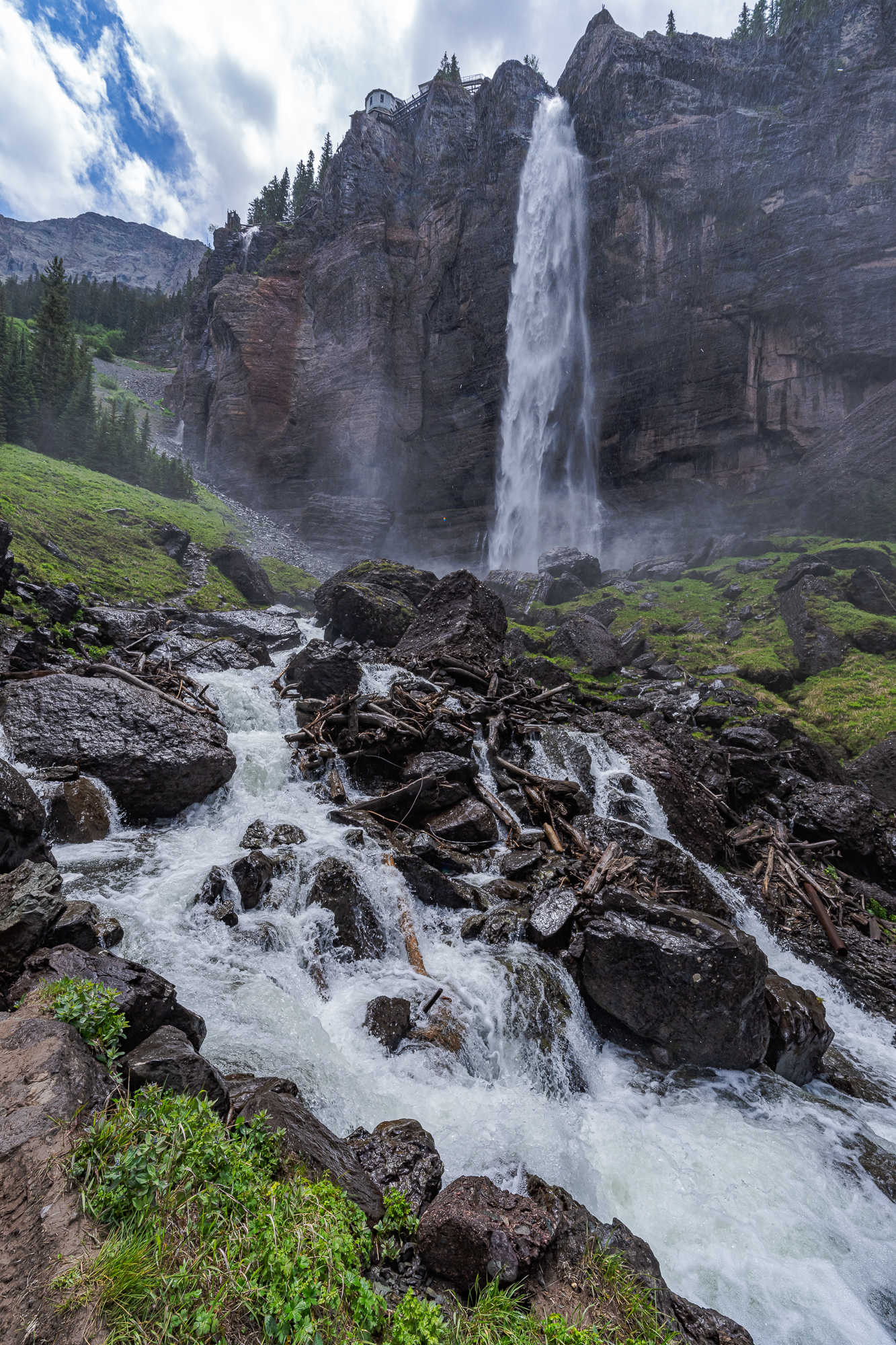
The above image captures both the creek and the full falls in one frame because of the 103-degree field coverage in the vertical capture. This image would not be possible with any lens longer than 14mm. The creek as shown is only five feet below the camera and is only a 20-foot stretch. Yet it doesn’t appear out of proportion compared with the 360-foot falls due to the lack of distortion in this lens. Following is a horizontally framed image taken from the same spot. It shows the lower portion of the falls in conjunction with a broader view of the creek area, a perspective that would also be impossible with a less wide focal length.
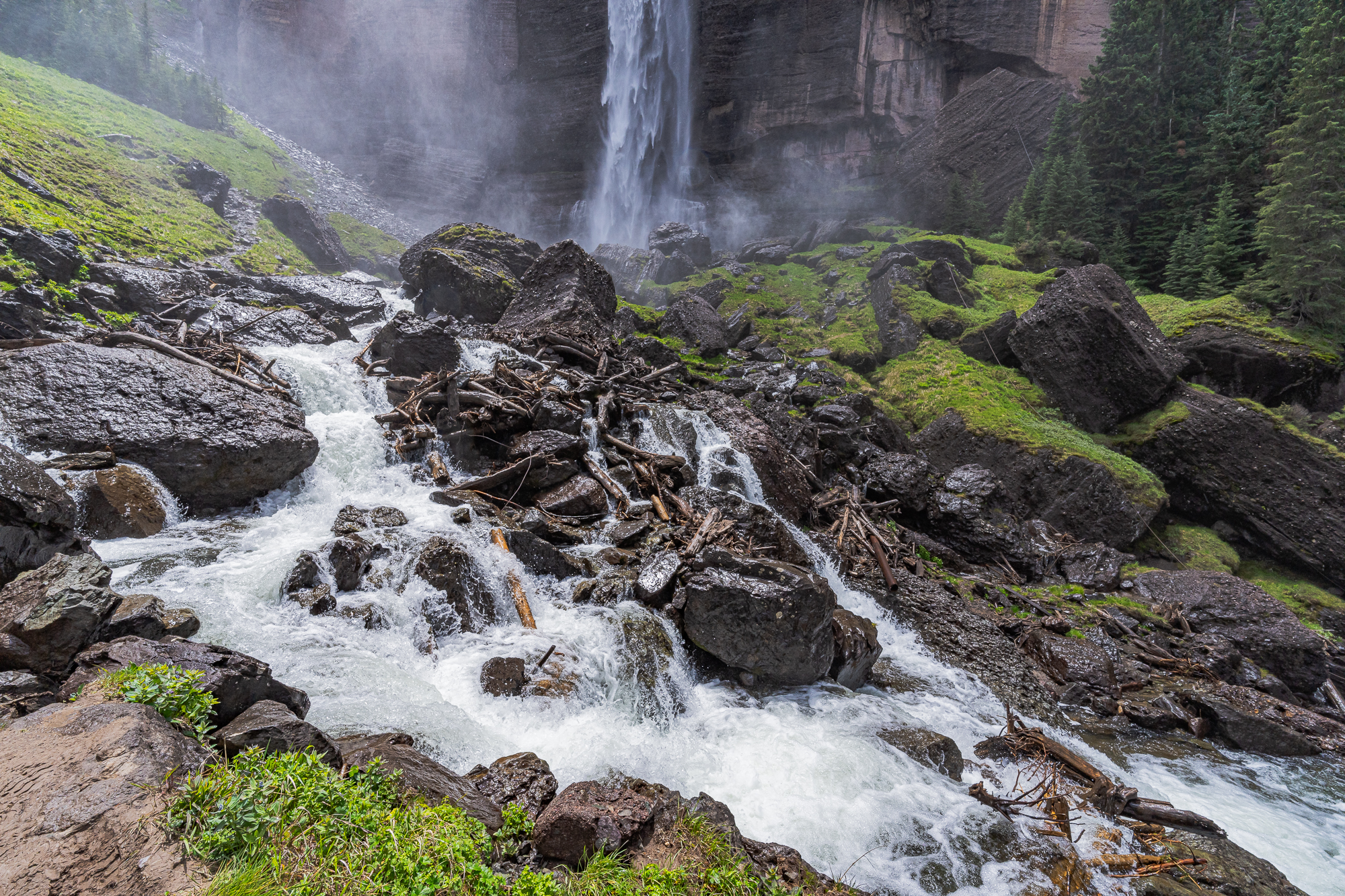
Views of a large waterfall will often be different even if taken from the same spot because of fluctuations in lighting and in the amount of spray. The image below is a little more dynamic because it shows more spray at the bottom of the falls.
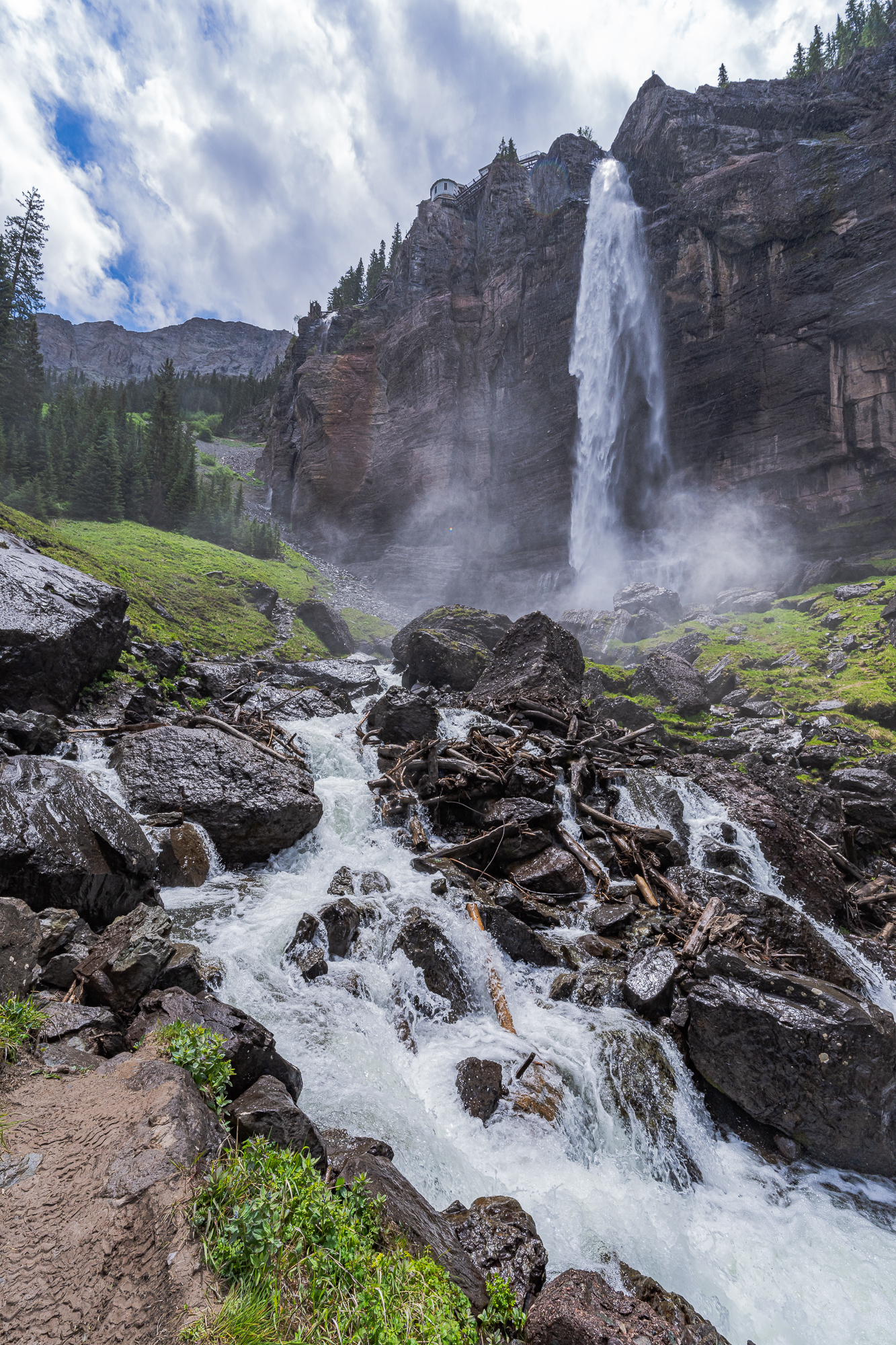
But, one of the consequences of spray is that not only does the photographer get wet, so does the camera and lens. Fortunately, the Sony Alpha 1 and the Sony 14mm f1.8 are fully gasketed and water-resistant. However, the spray will leave little drops on the lens that are seen as small light circles in the picture as shown below.
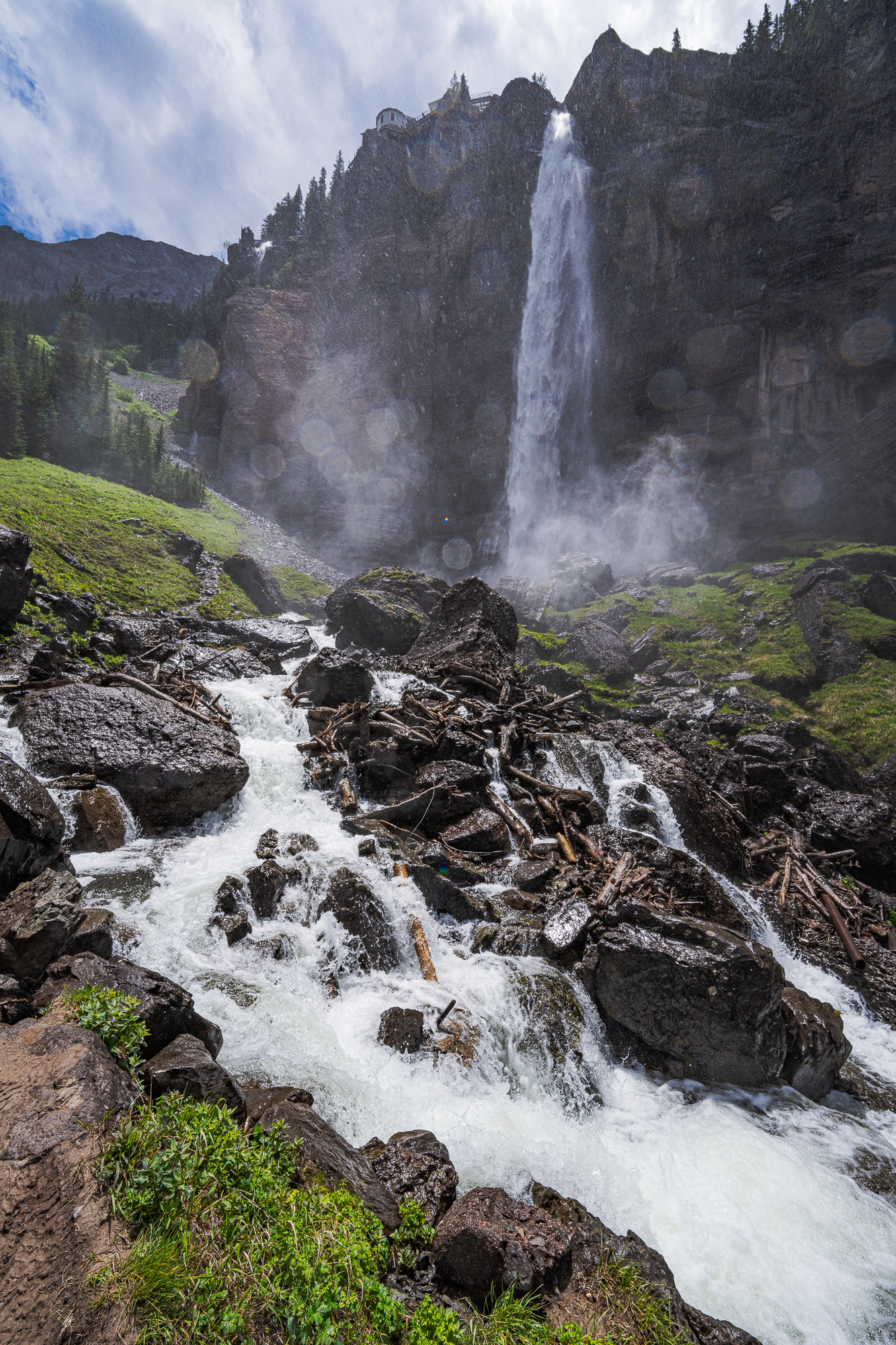
Near Bridal Veil Falls is Ingram Falls, a smaller waterfall at higher elevation to the left. The stretches of creek are mostly in bright sun while the vegetation is in shadow. Again, the 15-stop dynamic range of the Sony A1 and the low flare in the Sony 14mm f1.8 lens make the creation of a credible image easy.

Background-Dominant Landscape Images
I used the Desert Willow tree on the left side of the following image to frame the red rock formations along the Mogollon Rim at sunset. A little later in this article, the tree will be the main subject. In this case, the beauty and complexity of this tree provides more drama to the scene than would any ordinary tree or shrub, and helps paint a picture of exotic and diverse elements catching the last rays of light at sunset. Again, this image is only successful because of the extraordinary capability of the Sony 14mm GM lens.

Foreground-Dominant Landscape Images
The following image was taken at Woods Lake near Telluride CO. However, I chose to place the carved Aspen tree in the close foreground to make a statement. This lake is at the end of a long dirt road, in a relatively primitive area that only a few hunters and fishing enthusiasts visit. But, even here, some visitor had to put his or her mark on the scene. I believe that Chief Seattle (for whom the city is named) said it best: “Take only memories; Leave only footprints.” This lens gave me the capability of making a clear statement of why that advice is so cogent.
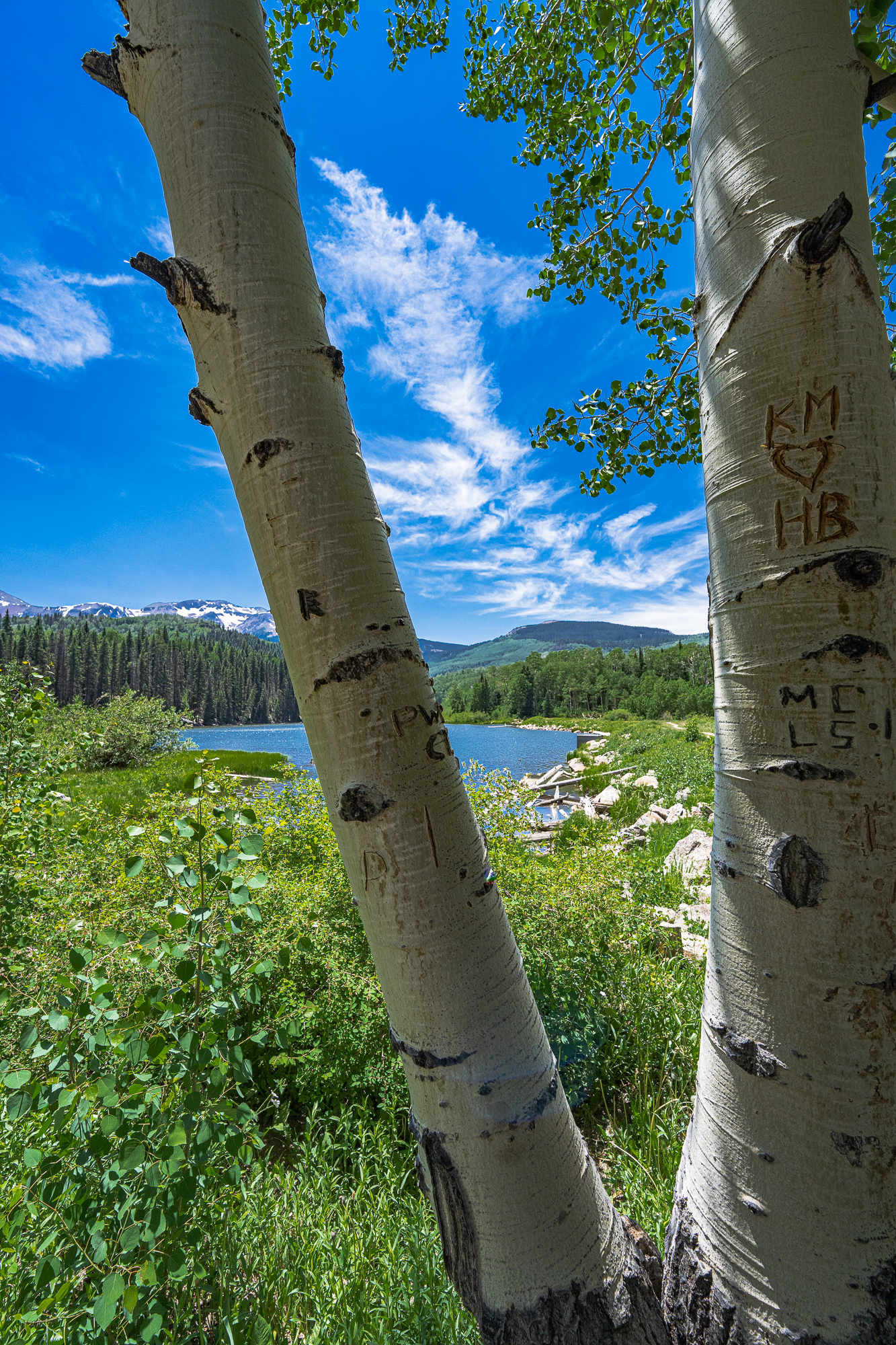
This next image is foreground-dominant but in a subtle way. The grasses at the lake edge don’t grab attention unless the viewer looks much closer. Among the blades of grass are a number of electric-blue Damselflies, hundreds of which inhabit the edges of Woods lake. The foreground isn’t really dominant, but is worthy of more attention. In any case, the point is that this Sony 14mm GM lens gives the photographer an effective tool to emphasize what he or she considers important within a broader scene.
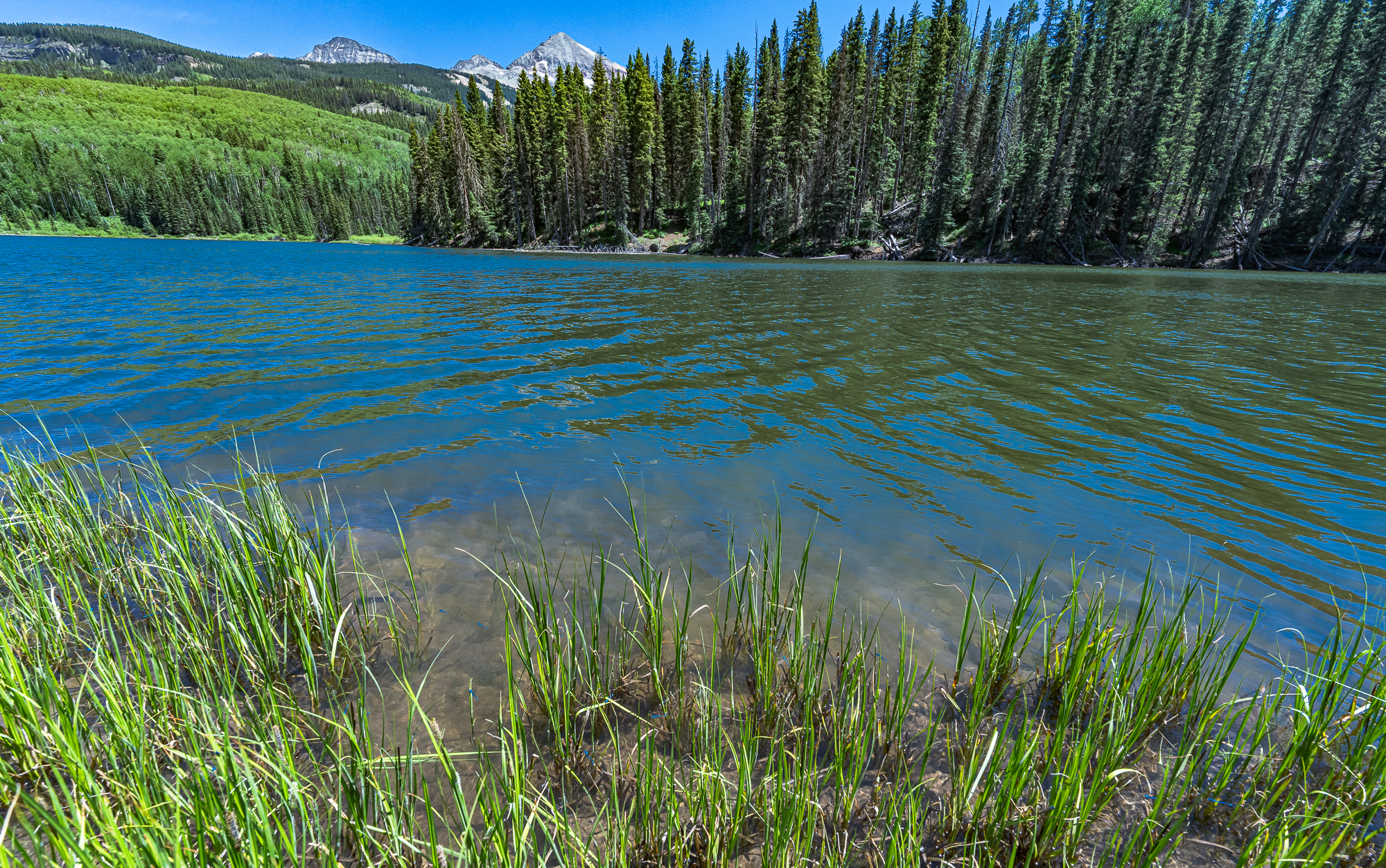
Intimate Landscapes
The 14mm f1.8 GM lens also excels in photographing large objects close up, and allows emphasis of smaller details by placing them closer to the camera. Any ultrawide lens will accomplish this. The 14mm GM just does it better. Following are two images of the same Desert Willow that I used to frame the Mogollon Rim at sunset. However, in these images, the tree is the whole show. It has small delicate pink bell-shaped blossoms which are best photographed at minimum distance from the camera. The Sony 14mm GM lens allows this while still showing the whole tree.
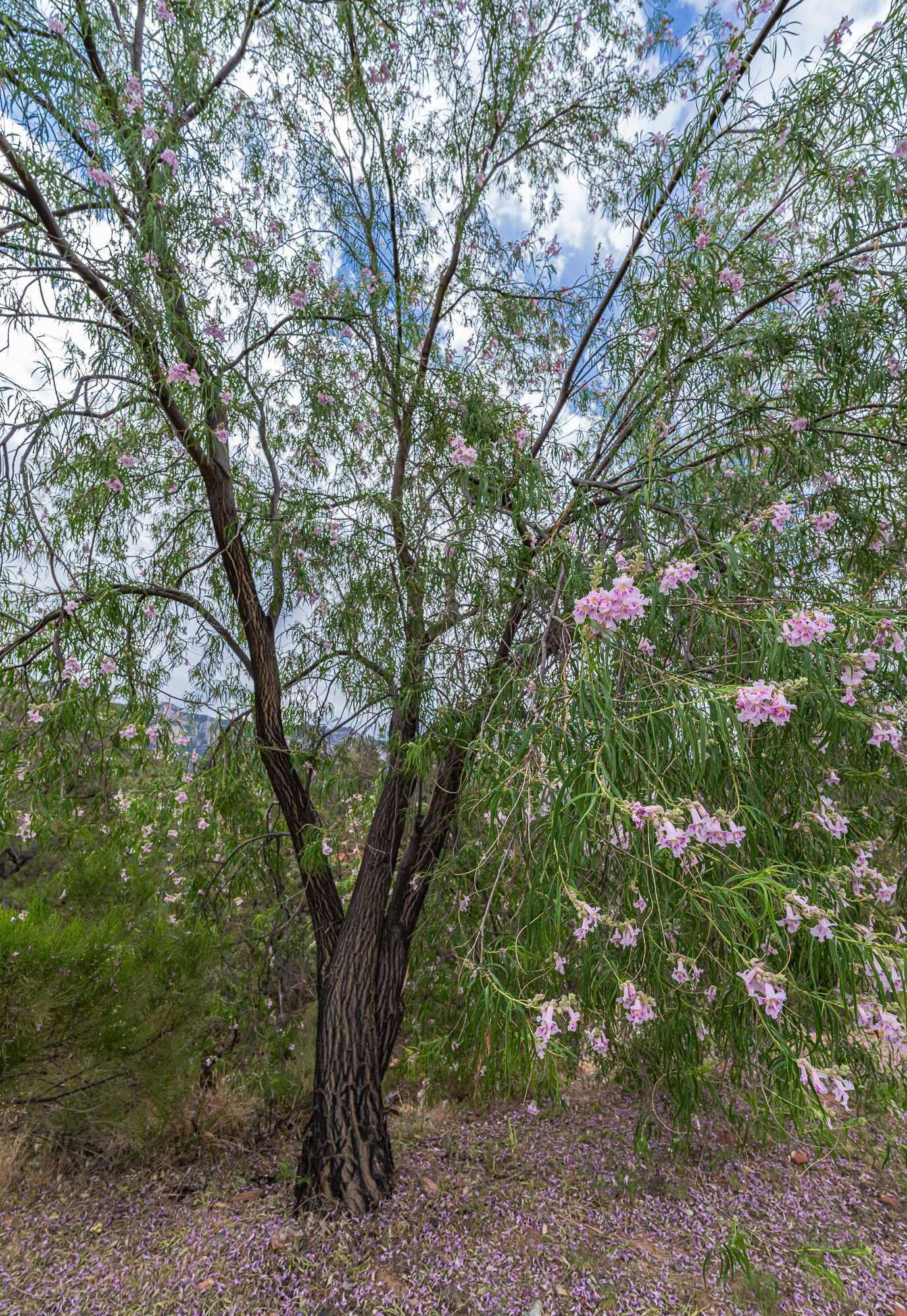
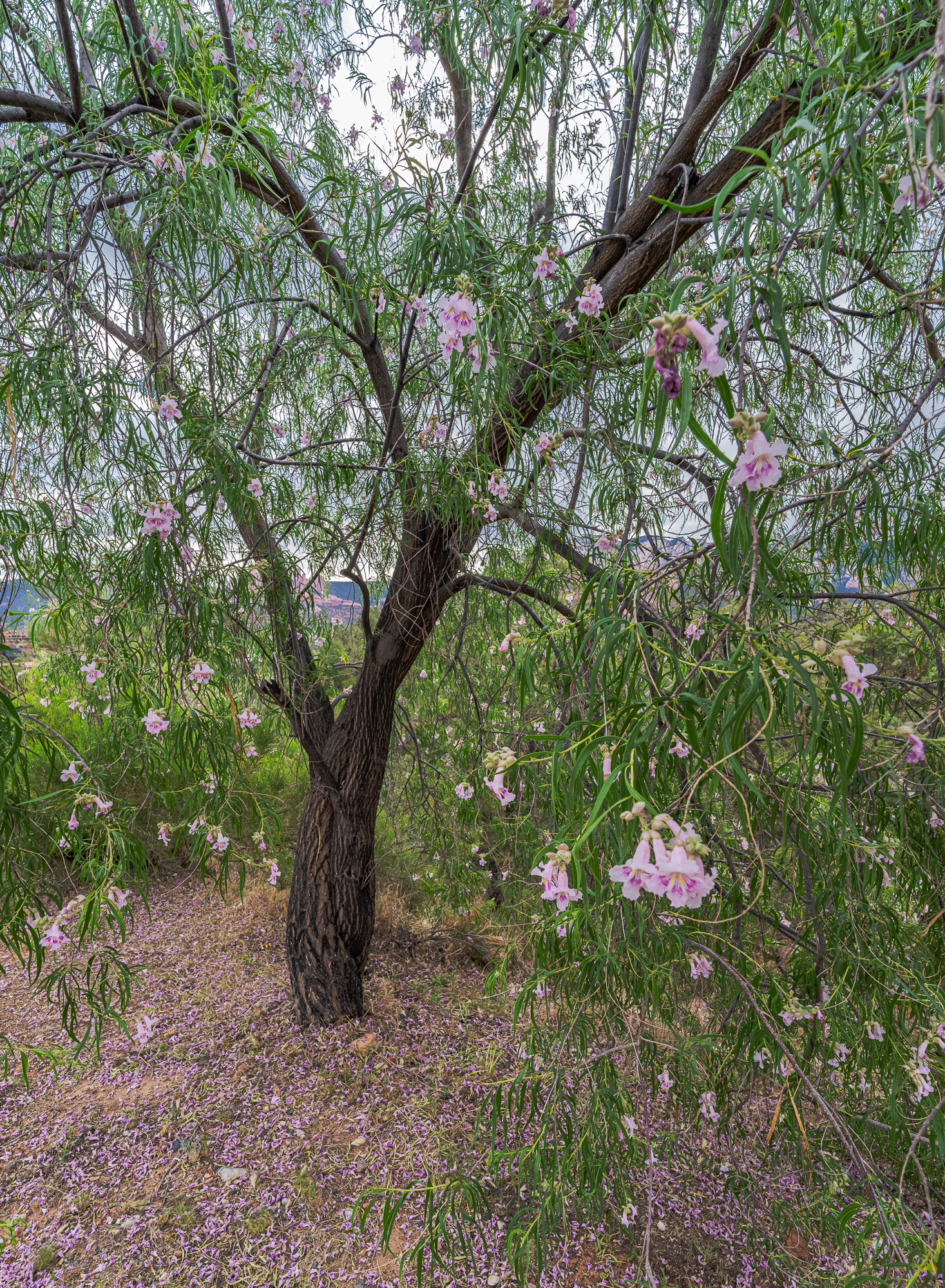
Architectural Images
Because of the outstanding distortion-free character of this lens, it is a natural for capturing exciting images of modern buildings like the Broad Museum in Los Angeles, and many others in large cities all over the world. In the last thirty days, the closest I’ve been to any structure that has interesting lines and contours has been the Amitabha Buddhist Stupa in Sedona. A unique far-eastern structure that is said to embody the spirit and meditative power of the Dharma or Buddha, the stupa is supposed to relax the mind and open it to peace and tranquility.
On the day and exact hour that I took the following image, there was a lot of energy in the air. Clouds were shredded into wild wisps that streaked the sky. The Sony 14mm GM lens captured the beautiful geometry of the stupa, the colorful prayer flags emanating from the top of the stupa, and the incredibly active sky above. I could not have envisioned such a fitting portrayal on my own. It was only when I saw the image in the viewer that I realized what I had captured.

Post note: I mentioned flare control several times in this article. Sony has come close to eliminating flare in this 14mm GM lens. To demonstrate this capability, I shot directly into the sun, making it part of the image. Following is a direct “sunstar” image of the sun in the background with Agave blooms and Pine trees in the foreground. Take note of the absence of flare, the uniform deep blue sky, and the sharp detail in the Agaves and pine trees. I’ve never seen anything close to this performance. It renders the old adage – “shooting with the sun behind you” – rather meaningless!

Further Thoughts
In the days and months ahead, I will be spending a lot of time with the Sony 14mm f1.8 GM lens mounted on my Sony Alpha 1 camera in an attempt to discover all of its capabilities and idiosyncrasies and will follow up with another article on this groundbreaking lens. Even at this early stage, one thing is already clear: used with both forethought and openness to the possibilities, this lens produces an incredibly high percentage of winning images.
The Sony 14mm f/1.8 GM Lens is available at Roberts Camera and B&H Photo
Harvey Stearn
July 2021
Sedona, AZ
To see the scope and essence of Harvey Stearn's photographic art please visit www.CameraStops.com. Mr. Stearn began photographing Western landscapes and wildlife at the age of 13, spent 50 years pursuing his passion in the field and in the darkroom before fully converting to digital photography in 2002. He developed color prints as well as monochrome, but switched over to digital capture and editing in 2002. Though he was a top executive for two large scale land development and home building corporations, he always found time for his fine art photography which won many awards. His work was exhibited in art museums in Southern California and Arizona, and was also featured in billboard advertisements and published in magazines. Mr. Stearn served on the California Arts Council for nine years, including two years as Chairman and another two as Vice Chairman. In addition, he was the founding Chairman of the John Wayne Airport Arts Commission in Orange County, California. Mr. Stearn’s work was sold through Arizona galleries for 15 years. In recent years he wrote 33 illustrated articles for PhotoPXL.com and 14 articles for Luminous-Landscape.com. In 2013 he published a book entitled “In Search of the Old West” which has been widely acclaimed. He was a guest lecturer on photography on a cruise ship visiting Chile, Argentina, Uruguay and the Falkland Islands. His work was among the top 100 images printed in NANPA's Showcase publications in 2019 and 2020. Images have been edited and selected for two new books on Landscape photography which will be published in late 2024 and early 2025.





